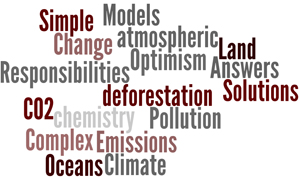
Complex Models, Simple SolutionsDec 18, 2009 - Gavin
Schmidt - The Earth Institute This is the twenty-ninth of a continuing
series of essays and interviews from Earth Institute scientists on the prospects
for a global climate-change treaty. Check with us daily for news and perspectives,
and to make comments, as events unfold throughout the Copenhagen meetings.  Everyone
knows that climate change is complex. The multitude of potential impacts, the
uncertainties in projections, the intersection of historical responsibilities
and current political realities all make negotiations fiendishly difficult. But
can the very complexity of the subject be helpful in finding solutions? The answer
might be yes. Everyone
knows that climate change is complex. The multitude of potential impacts, the
uncertainties in projections, the intersection of historical responsibilities
and current political realities all make negotiations fiendishly difficult. But
can the very complexity of the subject be helpful in finding solutions? The answer
might be yes.
The first ground for optimism is that the activities creating
the bulk of CO2 emissions are associated with other problems: air pollution, water
pollution and stress on ecosystems. Secondly, there are climatic impacts associated
with other emissions: for instance, the warming effects of ozone precursors and
soot, and the cooling effects of sulfur dioxide. These observations certainly
complicate climate calculations; but they also provide potential opportunities
for benefits that would come along with actions to reduce pollutants that affect
climate. First, though, we need to address how to quantify these impacts. Over
the last five years, there has been a revolution in the models used to simulate
the climate system. The models have become far more comprehensive. In addition
to the more traditional function of examining the impacts of increasing CO2, they
now include many previously neglected earth processes, such as the workings of
atmospheric chemistry; the creation, transport and deposition of different particles
that float around in the air; representations of how carbon move in and out of
oceans and land surfaces; and other manmade changes to the earth, from deforestation
to stratospheric ozone depletion. This means it is now possible to calculate the
net impact on climate and air pollution of particular industrial, residential
and agricultural sectors, including many indirect effects that we never really
looked at before. Our own research the Goddard Institute for Space Studies
has identified two sectors in particular where there are significant co-benefits
to reducing what we introduce to the atmosphere. The first is emissions associated
with surface transportation–a sector that produces a lot of CO2, but also nitrous
oxides (which are ozone precursors) and black carbon from diesel engines. Thus,
reducing emissions from this sector-accomplished by increased use of public transport,
switching to electric vehicles, or improved urban design–will lead not only to
reductions in three kinds of drivers of a warming climate, but reductions in local
air pollution, with accompanying improvements in public health. These reductions
will occur even if the energy for transportation is produced with the same mix
of sources that produces electricity today. Increases in renewable sources would
make it an even better proposition. Second, there is tremendous opportunity
to reduce emissions from residential burning of coal or biomass for cooking and
heating. This type of energy generation has largely disappeared in the more developed
economies, but is still common in India and China, where there is a great deal
of low-temperature combustion. Inefficient coal burning produces carbon monoxide
(another ozone precursor), copious quantities of soot, and also sulfur dioxide,
depending on the source of the coal. The use of biomass instead (wood or dung
for instance) also produces air pollution, often leads to very serious interior
air quality problems, and drives deforestation. Electrification of rural areas
where these practices are prevalent would make sound sense not only for climate,
but economic development. By looking at a complete analysis of the different
sectors and sources of emissions, we can get a better quantification of the true
impact of any particular activity. In the cases on India and China, the co-benefits
of better air quality, reduced deforestation and better public health may be enough
to encourage the exploration of international collaborations to reduce CO2 emissions.
Developed countries would see many of the same benefits by moving ahead with new
technologies. Climate and climate models may be complex, but some of the answers
to our problems might be simpler than we think. Gavin Schmidt is a climate
modeler at NASA Goddard Institute for Space Studies, and cofounder of the blog
realclimate.org.

|



 Everyone
knows that climate change is complex. The multitude of potential impacts, the
uncertainties in projections, the intersection of historical responsibilities
and current political realities all make negotiations fiendishly difficult. But
can the very complexity of the subject be helpful in finding solutions? The answer
might be yes.
Everyone
knows that climate change is complex. The multitude of potential impacts, the
uncertainties in projections, the intersection of historical responsibilities
and current political realities all make negotiations fiendishly difficult. But
can the very complexity of the subject be helpful in finding solutions? The answer
might be yes.